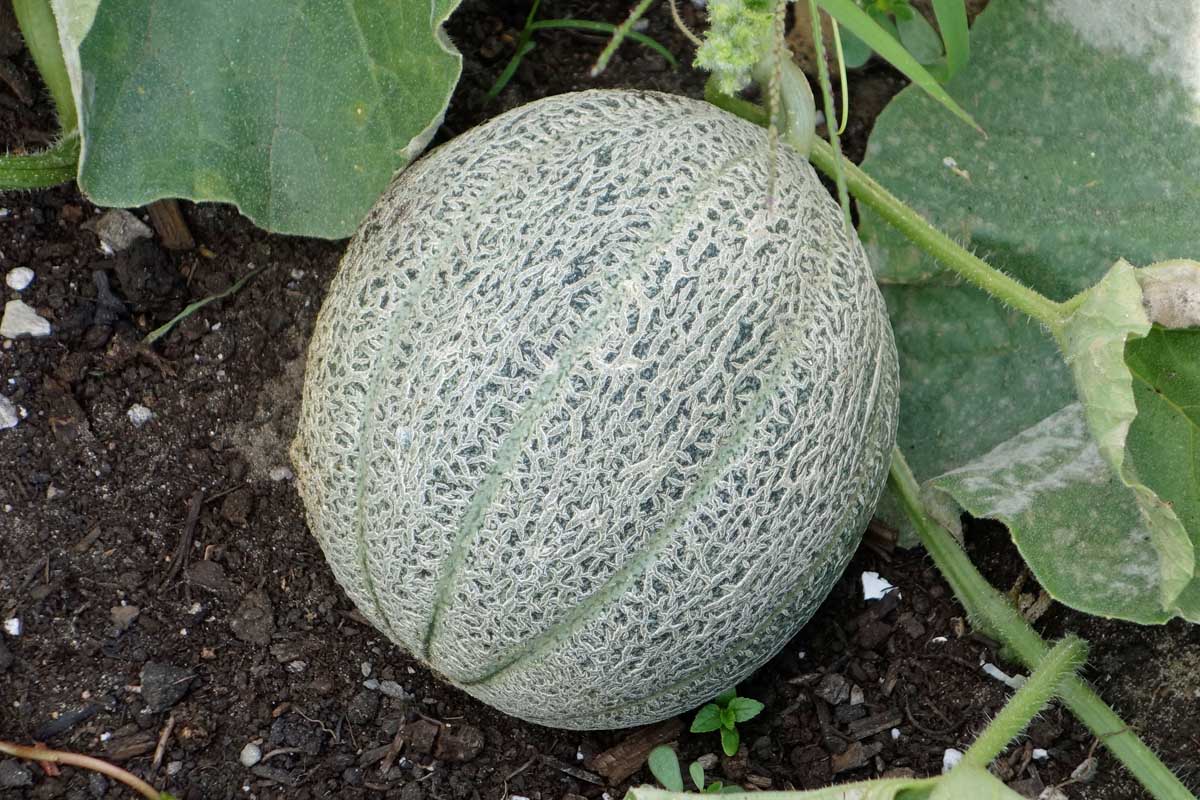How to Start From Seed
Cantaloupe is a warm-season crop and should not be planted until all danger of frost has passed. The ideal climate for growing cantaloupe consists of a long, frost-free season with plenty of sunshine and heat, and relatively low humidity. USDA Zones 4 -10 are suitable for cantaloupe and muskmelon [See Frost Dates].
Planting should commence in the spring, when the soil temperature is 65 to 85 degrees Fahrenheit. Soil should be turned with the previous crop residues buried at least two to three weeks prior to planting. This will allow sufficient time for these residues to decompose.
Plant seeds about 1 inch deep. Sow about 3 to 6 seeds per foot. Your rows should be approximately 50 to 70 inches apart. After emergence, thin down to about 1 plant every foot. After the seedlings have developed their third set of leaves they should be thinned to three plants per hill.
Remove weeds as they grow, and hoe lightly to avoid disturbing the shallow root system of the plant. Layer the ground around the plants with Mulch to cut back on weed growth, increase soil moisture, and keep the soil continuously warm.
How to Grow from Transplants
Some growers prefer to use transplants as a way of obtaining early melons. When growing transplants, seed 2 to 4 weeks ahead of transplanting date.
Commercial potting mixes work well since the growing medium must be sterile and drain freely. The diameter of transplant containers can range between 1.5 to 4 inches, with 3 inches being optimum for early production.
Maintenance of Cantaloupe Vines
Pollination
Many Gardeners sometimes wonder why the earliest Melon blossoms do not set fruit. The first flowers developing on the vines are male or pollen-bearing flowers. Only the female flowers are capable of developing into fruit.
Watering
Irrigation prior to and after planting should be applied to ensure seed germination and emergence. Drip irrigation provides the plants with a more uniform application of water, placing it near the root zone and using less water.
Drip irrigation also minimizes the amount of foliage and fruit disease compared with overhead irrigation. Drip Irrigation does not interfere with honeybees and subsequent pollination and fertilization. Inexpensive drip Irrigation Systems are available.
For larger plantings – drip systems can be easily adapted for the injection of fertilizer. This allows plant nutrients to be supplied to the field as needed.
Fertilizer
When setting out transplants, apply a common starter solution such as 20-20-20 . Medium-textured soils (loams) will generally produce higher yields and better quality melons.
In all cases the soil must exhibit good internal and surface drainage. Mulching is also recommended to help control weeds and maintain adequate soil moisture. Plants that are mulched grow faster and healthier than those that are not.
The optimal Soil pH range is 5.5 -7.0.
Pruning and Trimming
Many cultivars produce excessive vine growth. Pruning the vines is necessary only if the melons are to be trellised,optional otherwise.
Pruning is performed to achieve a balance between vine growth and fruit set, it increases fruit weight while reducing the number of undesirable melons.
Melon vines produce a primary stem with many secondary branches [laterals]. A suitable pruning treatment for cantaloupes and muskmelons is to retain the primary stem and one of the first laterals while pruning all additional laterals up to and including the 6 -7th leaf node.
All secondary branches after the eighth node can be left unpruned on the plant. This method of pruning permits the vine to be easily trellised either by a net trellis or by using strings and vine clips.
Harvesting Cantaloupe
Over Ripe Cantaloupes left on the vine will eventually fall from the stem and rot, this is what nature designed them to do in order to spread and fertilize their seed. The fruit however at this point is inedible.
You can judge a cantaloupes maturity by testing the strength that the melon is attached to the vine. Press your thumb firmly on the stem at the point that it is connected to the melon. If the fruit starts to dislodge from the stem, it is ready for harvest.
To avoid over-ripening, always harvest cantaloupes before they naturally separate from the vine. Cantaloupes may also ripen further off the vine, but they will not get any sweeter once off the vine, as they can no longer concentrate their sugars. Cantaloupes are usually harvested at what is known as “three- quarters-” to ‘full slip.’
Smaller fruits should be pinched off the stem as the season closes to encourage the ripening of the larger fruits. The growing points of all the vines should also be pinched off at this time. one-fourth of the stem usually adheres and breaks rather than slipping free.
Cantaloupes mature in 80 to 110 days depending on the variety and growing conditions. Sugar content is the primary measure of maturity and quality. Once again – Sugar content does not increase once the melon has been removed from the vine.
Related: Tips for Saving Melon Seeds

